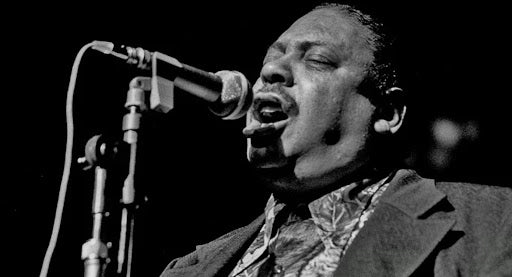t’s been 37 years since the blues pioneer passed away.
When we think of the blues, we usually think of B.B. King or revered blues musician Robert Johnson. It reminds us of fabulous eras like The Harlem Renaissance where the famed Apollo Theater gave birth to many of these genres. However, since we don’t explore our pioneering blues musicians very often, one of them being Big Joe Turner, we wanted to highlight the ways in which he shaped the culture, too.
Joseph Vernon “Big Joe” Turner was born May 18, 1911 in Kansas City, Missouri, Brittanica.com reports. He got his start singing as a young boy in church choirs and around his neighborhood. Working as a bartender in various Kansas City saloons, Turner started making a name for himself, often accompanied by pianist Pete Johnson. John Hammond, a jazz critic, was the first to discover Turner and Johnson, taking them and Turner’s smooth baritone voice to New York for the 1938 “Spirituals to Swing” concert at Carnegie Hall.
That initial performance became the spark. The duo stayed in New York as regular performers and a popular act at several NYC nightclubs where Turner could be seen putting on his “boogie-woogie” style of entertainment. The duo recorded their first singles “Roll ‘Em Pete” and “Goin’ Away Blues” for Vocalion Studios in 1938, BlackaPast.org reports. In 1939, they recorded “Piney Brown Blues,” selling more than 400,000 copies. Turner then moved to Hollywood in 1941 where he performed as part of Duke Ellington’s “Jump for Joy” Revue throughout the west coast until 1945. In 1944, Turner and Johnson recorded “Johnson and Turner blues,” earning Turner The Silver Award from Esquire Magazine for Best Male Vocalist in an All-American Jazz Band.
Turner then began recording with jazz musicians and touring the United States and Canada, oftentimes with legendary jazz artist Count Basie’s orchestra where he stood in as a substitute vocalist after Jimmy Rushing’s departure. Turner caught the attention of Atlantic Records Executive Ahmet Ertegun, who eventually signed him to the label. In 1951, he released his first string of top-selling rhythm-and-blues songs, including “Chains of Love,” “Sweet 16,” “Honey, Hush,” “Shake, Rattle and Roll,” and “Flip, Flop and Fly.”
Turner became known as the “Boss of the Blues” and was voted as Best Male Singer by Melody Maker magazine, also receiving an award for Best Blues Record by Jazz Journal in the United Kingdom in 1965.
He continued recording with a number of hit acts and continued touring with The Count Basie Orchestra. Eventually, he took his talents to the film world, appearing in a number of theatrical movies including the documentary Last of the Blue Devils (1979). He performed across the United States and Europe, appearing on TV and in jazz clubs, recording music up until the 1980s. In 1983, Turner was inducted into the Blues Hall of Fame and on November 24, 1985, he passed away at the age of 74.
In 1987, Turner was posthumously honored for his immense contributions and was inducted into the Rock and Roll Hall of Fame. Today, we remember the life and legacy of Big Joe Turner. Here are 5 must-see live performances from the “Boss of the Blues” below:
BIG JOE TURNER. Shake, Rattle & Roll. Live 1954 Performance from Rhythm & Blues Revue
BIG JOE TURNER. Oke-She-Moke-She-Pop. Live 1954 Performance.
Big Joe Turner – Hide And Seek – Version 2 (1966)
Flip Flop Fly – Big Joe Turner, 1966
BIG JOE TURNER AND THE JAZZ ALL STARS 1970 vintage club atmosphere
What a remarkable legacy! Because of Big Joe, we can!
Remembering Big Joe Turner: 5 must-see live performances from the Boss of the Blues. Photo Courtesy of Heinrich Klaffs/NPR

